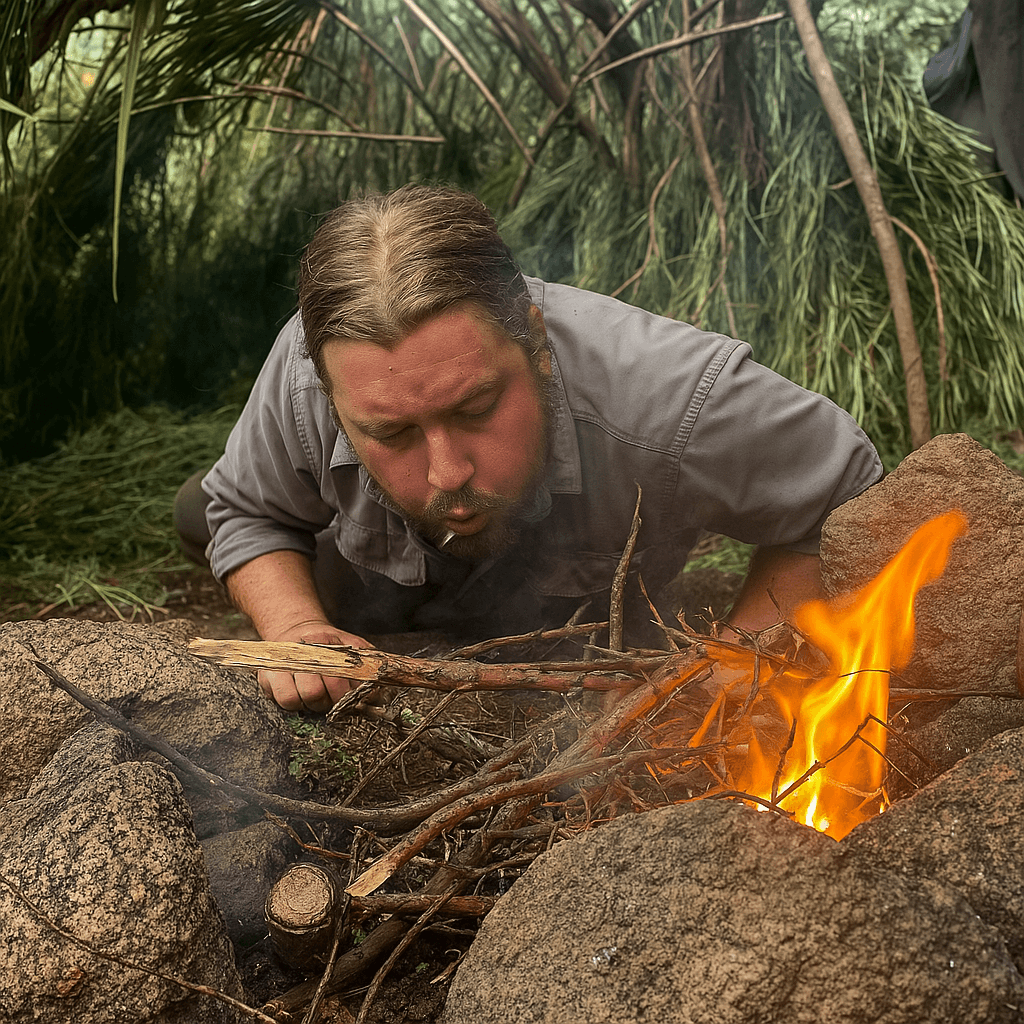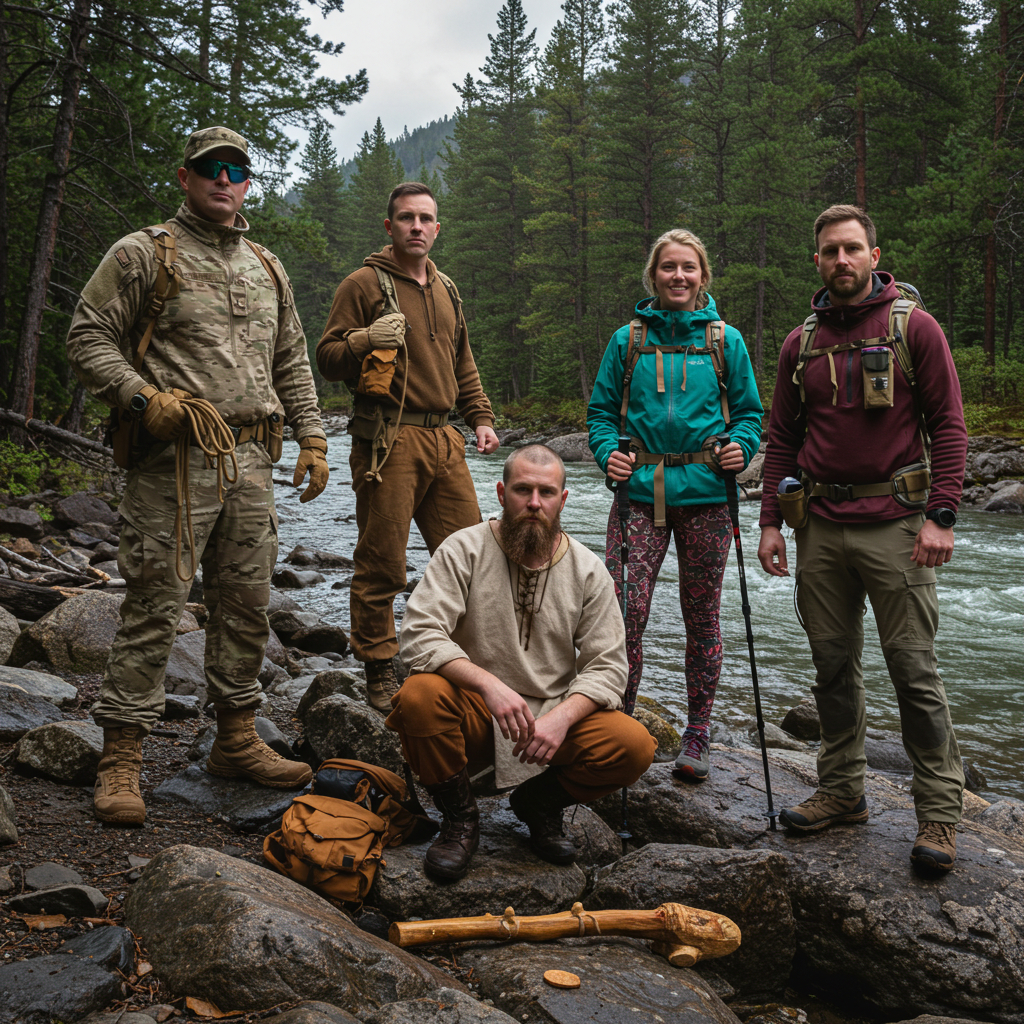Cart
10 min read
Mastering Winter Wilderness Survival

Mastering Winter Wilderness Survival: Embrace the Season, Don’t Just Endure It
The first snowfall has hit camp in the mountains where we train, bringing that familiar chill and the deep, quiet beauty only winter provides. For those of us who love the wilderness, winter isn’t a time to hibernate but an opportunity to explore and test our skills in a way that summer can’t match. However, winter survival isn’t for the faint hearted; it requires preparation, a shift in mindset, and a healthy respect for the cold.
Let’s talk a little about the art of surviving in the winter wilderness.
I. Understanding Winter’s Unique Challenges
Cold Weather and the Body
In winter, our bodies work overtime to keep us warm, burning more calories in the process. This is why winter survival often feels physically draining. Pack calorie-dense foods like nuts, jerky, and chocolate to stay fueled without weighing down your pack. Watch for signs of hypothermia, such as shivering, numbness, and confusion, as these can come on faster than you expect.
Mind Games of Darkness and Isolation
Winter brings longer nights and quieter days, which can challenge your mental game.
The darkness can feel all-encompassing, amplifying isolation and intensifying the mental strain of survival. Unlike summer, where daylight offers long hours of activity and a sense of comfort, winter demands resilience in solitude and requires a different level of mental fortitude.
One of the best strategies for overcoming these challenges is to embrace the stillness rather than resisting it. Allowing yourself to accept the quiet and dark as part of the experience helps transform isolation into an opportunity for introspection. Many who thrive in winter wilderness find a calming rhythm in nature’s slower pace, using this time to connect deeply with their environment and themselves.
 Creating daily routines is another powerful tool. The simple acts of gathering firewood, organizing gear, and preparing meals offer a reassuring structure that breaks up the monotony and keeps you grounded. By setting small, achievable goals each day, you give yourself a sense of purpose and accomplishment, preventing feelings of aimlessness. Tasks that may seem minor, such as maintaining the fire, clearing snow from around your shelter, or even just brewing a hot drink, become meaningful rituals that bring comfort and control to the situation.
Creating daily routines is another powerful tool. The simple acts of gathering firewood, organizing gear, and preparing meals offer a reassuring structure that breaks up the monotony and keeps you grounded. By setting small, achievable goals each day, you give yourself a sense of purpose and accomplishment, preventing feelings of aimlessness. Tasks that may seem minor, such as maintaining the fire, clearing snow from around your shelter, or even just brewing a hot drink, become meaningful rituals that bring comfort and control to the situation.
Additionally, the quiet isolation of winter sharpens your senses and awareness. With fewer distractions, you can focus fully on observing subtle changes in your surroundings, learning to read cues in the snow, trees, and weather patterns. This heightened awareness becomes an asset, enhancing your survival skills and deepening your understanding of the environment.
In winter survival, solitude and darkness can be challenging, but they can also provide clarity and mental strength. Embracing the quiet allows you to develop resilience, adaptability, and a profound connection to nature that extends beyond mere survival.
Routines and Rituals for the Cold
Sometimes, it’s the little rituals that keep you going—a hot cup of tea, checking traps, or a quiet moment to breathe. These simple acts ground you, stave off loneliness, and keep you focused on the next step.
II. Preparing for the Cold: Gear and Mindset
Layering Up Like a Pro
Good layers are vital for warmth and regulating body temperature. Start with a moisture-wicking base layer, add insulation like fleece, and finish with a windproof and water-resistant outer shell. Avoid sweating too much—wet clothes cool you down quickly. A spare dry set of clothes can be a lifesaver. For more details on staying warm and layering effectively, check out our blog on The Principles of Clothes Layering.

Stay Dry, Stay Alive
Winter survival is all about managing moisture, as staying dry is key to retaining warmth. Shed layers before strenuous activity to avoid sweat buildup, and add them back as you cool down to prevent chills. Snow and condensation can soak your gear quickly, so keep gear like your sleeping bag, clothes, and food carefully sealed and dry. Damp gear not only makes it harder to stay warm but also increases the risk of hypothermia in cold conditions. Planning ahead to keep moisture out can make all the difference in a successful winter adventure.
Making Fire in a Snowy Landscape
Fire is your best friend in the cold, but snow-covered wood can be tricky to light. Clear an area down to the ground or use rocks or logs as a platform. Birch bark, loaded with natural oils, can burn even when damp. Fire-starters like petroleum jelly-soaked cotton balls or pine resin chunks are important to carry.
III. Building a Winter-Ready Shelter
Choosing the Right Shelter
Snow can actually be a valuable resource when building a shelter, providing natural insulation that helps trap body heat. A well-constructed snow cave, for instance, can keep you significantly warmer than the open air by protecting you from wind and maintaining a more stable interior temperature. If snow isn’t deep enough for a cave, simpler options like a lean-to or tarp setup can still offer protection. Just be sure to position your shelter with wind direction in mind as wind chill can quickly strip away body heat, making even the most robust shelter ineffective without proper placement. If you’d like to learn more about building effective shelters, our Outdoor Survival Skills 101 class covers essential techniques to keep you protected in the wilderness.
Insulation Tips for Staying Warm
To maximize warmth, use good insulation in your shelter. Pine boughs or packed snow around the shelter help trap heat. If using natural materials, aim for at least a foot of thickness. Remember, heat rises, so create a raised platform off the ground to keep yourself warmer.
Fire Inside the Shelter: A Balancing Act
A small fire inside or near your shelter can provide warmth, but it’s a delicate balance. Too close, and you risk carbon monoxide or a fire hazard; too far, and it’s less effective. Create a fire reflector with logs or rocks to bounce heat back and crack a vent if your shelter is enclosed to keep fresh air circulating.
IV. Food and Water in Snow-Covered Terrain
Winter Foraging and Trapping
 Finding food in winter is a true test of survival skills, requiring knowledge of the land and a keen eye for resources hidden in the snow. Evergreen trees, such as pine and spruce, offer needles rich in Vitamin C, which can be steeped to make a nutrient-boosting tea. While the frozen ground makes digging challenging, certain roots and tubers are still accessible if you know where to look, providing carbohydrates that help sustain energy in the cold.
Finding food in winter is a true test of survival skills, requiring knowledge of the land and a keen eye for resources hidden in the snow. Evergreen trees, such as pine and spruce, offer needles rich in Vitamin C, which can be steeped to make a nutrient-boosting tea. While the frozen ground makes digging challenging, certain roots and tubers are still accessible if you know where to look, providing carbohydrates that help sustain energy in the cold.
For protein, trapping small game like rabbits becomes necessary. Setting traps near natural shelters, such as under tree roots, rock overhangs, or dense shrubs, improves your chances, as animals often seek protection in these spots during harsh weather. Observing tracks and signs of animal activity can guide you to the best locations. Winter foraging and trapping are slow but rewarding practices that push your patience and adaptability, turning the wilderness into a provider if you’re prepared to work with nature’s winter offerings.
Water: Not as Easy as Eating Snow
While eating snow might seem easy, it lowers your core temperature and depletes energy reserves. Melt snow in a pot or a makeshift container near a fire.
Drinking cold water or eating snow forces your body to use valuable energy to warm it up, which can be a risk in freezing conditions. If possible, collect ice instead of snow, as it provides more water per volume when melted, helping you conserve fuel and effort.
V. Navigating Through a Winter Wonderland
Land Navigation Tips
Winter’s snow blankets the landscape, transforming familiar trails and landmarks into a uniform white expanse that can easily disorient even experienced adventurers. Always carry a reliable map and compass, and know how to use them in tandem for accurate navigation. Winter navigation often means relying on subtle cues in the environment, look for wind patterns that reveal snow drifts or spot animal tracks that may lead toward sheltered areas and water sources. Reading these clues not only helps you stay on course but also deepens your awareness of the natural rhythms in the winter wilderness, making navigation an essential part of winter survival.
Avoiding Risks Like Avalanches and Icy Crossings
Snow-covered slopes may look stunning but can be deadly if avalanche-prone. Learn to read snow layers on steep terrain and be cautious around frozen rivers or lakes. Even thick-looking ice can have weak spots. When in doubt, find an alternative path.
VI. Keeping Morale High in the Cold
Mental Resilience: A Survival Superpower
 Winter survival demands a unique level of adaptability, where mental resilience becomes as critical as physical readiness. The unpredictable environment challenges you to think on your feet, respond quickly to changing conditions, and find creative solutions with limited resources. Embracing a flexible mindset is key, as rigid plans often give way to nature’s own pace.
Winter survival demands a unique level of adaptability, where mental resilience becomes as critical as physical readiness. The unpredictable environment challenges you to think on your feet, respond quickly to changing conditions, and find creative solutions with limited resources. Embracing a flexible mindset is key, as rigid plans often give way to nature’s own pace.
Self-discipline also plays a significant role in building resilience. Sticking to essential routines—such as monitoring gear, managing supplies, and preparing for temperature drops—helps you stay focused and prepared. Adopting these practices consistently, regardless of fatigue or discomfort, instills a sense of control and confidence in unpredictable conditions.
In moments when resources run low or plans don’t go as expected, resourcefulness becomes a vital skill. Crafting tools from found materials or finding unexpected ways to insulate your shelter reinforces your ability to adapt. Building mental resilience in winter survival isn’t just about managing isolation; it’s about engaging with challenges proactively and using each task as an opportunity to strengthen both your skills and your resolve.
Embrace the Season
 Winter survival isn’t just about holding out until spring; it’s about seizing the opportunity to connect with nature in its most intense and rewarding form. The cold challenges you in ways that are unique to this season, pushing your boundaries and strengthening your resilience. Every day in the winter wilderness brings a fresh test, a chance to adapt, learn, and grow.
Winter survival isn’t just about holding out until spring; it’s about seizing the opportunity to connect with nature in its most intense and rewarding form. The cold challenges you in ways that are unique to this season, pushing your boundaries and strengthening your resilience. Every day in the winter wilderness brings a fresh test, a chance to adapt, learn, and grow.
As you build fires, construct shelters, and navigate snowy terrain, you’ll discover a deep sense of peace within the vast, snow-covered landscape. Winter survival offers clarity, a slowing down that lets you truly listen to the quiet rhythms of nature. When prepared mentally, physically, and with the right gear, winter becomes a season of personal growth, resilience, and unforgettable experiences.
So bundle up, bring your best fire-starting tricks, and dive into the icy beauty of the wild.
Winter awaits! Make it Yours
Did you like these survival tips? Check out more tips and trick on our Wilderness Survival Tips page.
If you are looking for hands on training to learn more about wilderness survival and want to take months if not years off of your learning curve, I suggest you check out our 5 Day Outdoor Survival Basics 101 class!
#survivalskills #survivalgear #wildernessculture #outdooreducation #wildernesssurvival #WinterSurvival #ColdWeatherSkills #SurvivalTraining #WildernessSurvival #OutdoorSkills #WinterCampingTips #SurvivalMindset #BackcountryAdventure #StayWarmOutdoors #WinterPreparedness
Leave a Comment
What Nash Quinn’s Disappearance Teaches Us About Being Ready for the Backcountry
Nash Quinn vanished on a routine ride near Laramie. His story is a powerful reminder of why preparation, communication, and humility in the outdoors matter...
Recommended Gear List For Courses
Colorado is a cold weather climate most of the year and with our survival school at 9400 feet, it can get frigid at night, even…
Survival Training Near Me: Why the Best Might Be Worth the Trip
Discover why the best survival training might mean leaving the city. Explore The Survival University’s 4000+ acres and 20+ expert instructors!
Bugging In Guide Part 1: Drain Your Water Heater
Learn how to access hidden water in your home by safely draining your water heater during emergencies. A must-read for urban survival and bugging in.
Flint Knapping for Beginners: My Hilarious Failures & How to Do It Right
Flint knapping sounds easy—until you try it. Here’s my journey of frustration, flying shards, and why some people (but not me) make it look effortless.
What to Do When You Encounter a Wolf in the Wild
Wolves are neither villains nor heroes—they’re survivors. Explore their role in nature, the myths that surround them, and what we can learn from their resilience.










